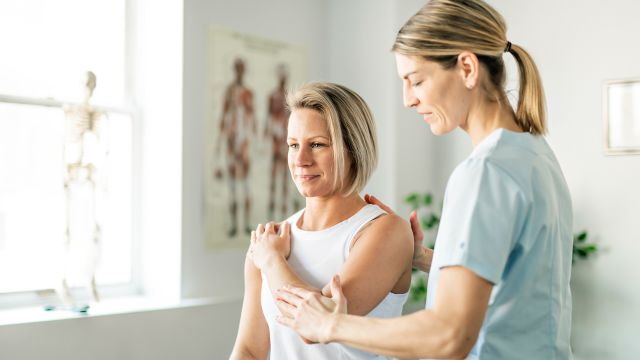Anyone who experiences joint pain—and associated symptoms such as stiffness, achiness or soreness—knows that it can make daily activities a chore and even diminish your quality of life.
Pain in the joints may derive from a variety of injuries and conditions, including rheumatoid arthritis (RA), bursitis, osteoarthritis and tendinitis. It tends to be situated most commonly in the hands, feet, hips, knees or spine.
If the pain is related to inflammatory conditions like RA, symptoms tend to be worse in the morning but improve over the course of the day as you move and loosen up. Pain associated with degenerative conditions such as osteoarthritis, on the other hand, tend to get worse as the day goes on.
But luckily, for the more than 15 million Americans who experience some type of severe joint pain, there are ways to get relief. Talk with your doctor about which of the following methods might work best for you as part of your overall treatment plan.
At-home management: For pain associated with conditions other than arthritis, it may be possible to find reprieve through routine management techniques at home. Massages, warm baths and stretching can loosen joints and relieve discomfort.
Pain relievers: You might also try over-the-counter pain relievers like acetaminophen or nonsteroidal anti-inflammatory drugs (NSAIDs) like ibuprofen or naproxen. In some cases, your doctor may recommend stronger prescription doses. If you have stomach ulcers or kidney, liver or heart disease, check with your doctor to make sure these medications are safe for you.
Exercise: When you have joint pain, the last thing you probably want to do is exercise. But as long as you’re cleared by your doctor, it’s actually important to keep moving and it may be a valuable part of your treatment.
Without a regular exercise routine, it’s possible that your muscles and posture will become weaker, which in turn may cause more pain and discomfort. Exercise can also help increase your flexibility and strengthen muscles which, in turn, can help manage symptoms.
Low-impact workouts like swimming and walking are ideal for those with joint pain. Meanwhile, if you’re accustomed to high-intensity workouts like running, boot camp classes or heavy weight lifting, you may need to scale back and opt for something less strenuous.
Weight loss: Not surprisingly, carrying around extra weight puts pressure on load-bearing joints like knees and hips that may already be causing you pain.
Maintaining a healthy weight, or losing weight if you’ve overweight, can improve the health of your joints in a major way. According to Harvard Medical School, obese people who lose 10 to 15 pounds can reduce the risk of osteoarthritis down the road. And one 2005 study published in Arthritis & Rheumatism found that losing just one pound of weight relieved four pounds of pressure from the knees.
Talk with your doctor about a weight that’s healthy for you. Taking into account your body mass index (BMI), waist circumference and other health risk factors such as high blood pressure and cholesterol, your physician can help you understand whether or not you need to lose weight and can help you devise a healthy eating plan and exercise routine to help you drop pounds.
Topical treatment: Oral NSAIDs may be effective for treating joint pain, but there are also topical options in the form of gels, liquids or patches.
While they’re not for everyone (they can cause problems for those with sensitive skin), topical pain relievers may be a better option than oral NSAIDs if:
- You have arthritis-related pain in one or a couple of smaller joints like hands, elbows and ankles
- You’re over the age of 65
- Your stomach is sensitive to oral NSAIDs
- You have heart-related risk factors and your doctor doesn’t want you to take oral NSAIDs
Oral NSAIDs are absorbed into the bloodstream and can often cause stomach-related issues such as bleeding, ulcers or pain. While topical NSAIDs are absorbed into the bloodstream as well, not as much of the medication makes its way through the body, which makes them a good option for people for whom oral NSAIDs cause stomach problems.
Other treatments available for joint pain include supportive aids like braces to help you move around more easily, physical therapy, joint injections, prescription painkillers and, for severe cases, joint-replacement surgeries.
Your doctor can help you devise a treatment plan that may include a combination of these methods to get you as close to pain-free as possible.






